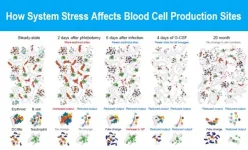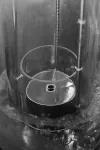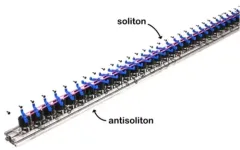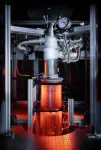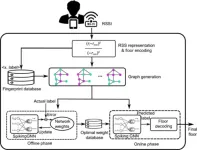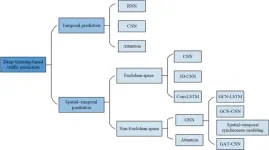(Press-News.org) Imagine being able to count the different types of blood cells being formed inside the tiny bones of a mouse and pinpointing the strings and clusters of cells within the bone marrow that are responsible for producing specific types of blood cells.
That’s exactly what a team of scientists led by experts at Cincinnati Children’s achieved in a far-reaching study published March 20, 2024, in the prestigious journal Nature. Their work adds unprecedented new understanding of the “elegant” and “resilient” anatomy of bone marrow while also generating evidence of unexpected variations in how the skeleton responds to stresses such as infection or blood loss.
“Stunningly, we found that the response to hematopoietic insults varies across the skeleton. We speculate that certain bones have specialized to preferentially respond to some insults, and this will be the focus of future studies,” the co-authors state.
The research was led by co-first authors Qingqing Wu, PhD, and Jizhou Zhang, PhD, and corresponding author Daniel Lucas, PhD, all with the Division of Experimental Hematology and Cancer Biology at Cincinnati Children’s. Overall, 23 researchers from five institutions contributed to this groundbreaking study.
The discovery of specific blood cell production sites within the bone marrow raises new challenges and opportunities for diagnosing and treating a number of blood-related conditions.
“For example, our data shows that biopsies that draw marrow from just one type of bone may not provide a full picture of how the blood production system has been affected by a disease or other insult,” Lucas says. “Meanwhile, efforts to stimulate production of certain blood cell types may be dramatically improved by focusing on specific bone types.”
Highlights of the findings
The key discoveries reported in the paper include:
New tools allowing visualization of blood production inside the bone, allowing defining the basic anatomy of blood cell formation. These revealed that bone marrow functions are highly responsive and durable, but not uniform. The paper describes how strings and clusters of cells form within the marrow to act as blood cell production factories.
Location matters, even during normal blood cell production. The team demonstrated that different key types of progenitor cells move through different microenvironments as they mature. These microenvironments significantly influence which types of mature blood cells get produced. Different microenvironments give rise to oxygen-carrying red blood cells versus infection-fighting white blood cells, and so on.
Unexpected variations in stress responses. The researchers compared how the system responded to three acute kinds of stress: blood loss, L. monocytogenes infection, and granulocyte-colony stimulating factor (G-CSF) treatment (often given to boost white blood cell production after chemotherapy). They also measured how aging changed the process.
The team meticulously measured how different bones responded to these insults. Among several examples: blood loss triggered rapid red blood cell production in the sternum, tibia, vertebrae, and humerus -- but not in the skull. Blood loss also temporarily reduced the number of B cell production sites across the skeleton.
Meanwhile, when exposed to G-CSF, long bones rapidly increased formation of granulocyte progenitors and mature neutrophils. But in sharp contrast, the sternum from the same mice displayed “profound reductions” in these cell types as well as loss of neutrophil production sites.
“These variations are important because until now, mouse studies of blood cell biology have depended almost entirely upon material collected from the femur and tibia,” Lucas says.
Innovation required just to conduct the study
The research team first needed to conduct a research project-within-the-project to establish a method for imaging and counting the different cell types at work within the mouse bone marrow.
Counting the cells involved a process called confocal imaging microscopy. This uses specialized microscopes relying on lasers to detect specific tags in the cells. When “tagged” properly, the cells emit different colors under the laser, which allows them to be imaged and counted.
The challenge is coming up with the right tag so that the laser accurately detects the targeted cells of interest, while not counting other cells. In this study, the team started with a vast library of potential markers, then they whittled the list down to 35 promising genetic markers.
Ultimately, they found that detecting cells that express the gene marker ESAM, in combination with other markers, allowed distinguishing between six different types of blood progenitor cells. The marker also proved capable of showing information about the microenvironment, such as whether blood cell production was occurring within sinusoids or arterioles, two distinct types of blood channels found within bone marrow. Importantly, the process developed for this study allowed the team to analyze blood cell development in multiple parts of the skeleton.
Next steps
Looking ahead, Lucas says much more research will be needed to fully detail how different parts of the skeleton become specialized producers of specific blood components. Also, more studies will be needed to confirm how much of the bone marrow stress response observed in mice also occurs in humans.
It will likely require several years of development, but understanding more about the mechanics of blood cell production may allow a wide range of improvements in the precision and effectiveness of treatments to support healthy blood cell production.
“It might even allow to build artificial bones capable of producing red blood cells for transfusion,” Lucas says.
About the study
Achieving these findings required significant support from the Bio-Imaging Analysis Facility and the Research Flow Cytometry Core at Cincinnati Children’s.
In addition to Wu, Zhang and Lucas, Cincinnati Children’s co-authors included: Sumit Kumar, Siyu Shen, Morgan Kincaid, Courtney B. Johnson, Yanan Sophia Zhang, and Shelli Homan, Marie Dominique Filippi, PhD, and H. Leighton Grimes, PhD, all with Experimental Hematology and Cancer Biology; Anastasiya Slaughter, Benjamin Weinhaus, and Baobao Song from the Immunology Graduate Program; Bryan Sherman, Tzu-Yu Shao, and Sing Sing Way, MD, PhD, from Infectious Diseases; and Matt Kofron, PhD, a member of Developmental Biology and director of the Bio-Imaging and Analysis Facility.
The study also included contributions from researchers with the Charles P. Lin lab at Massachusetts General Hospital, Harvard Medical School, and Keisuke Ito at the Albert Einstein College of Medicine in Bronx, NY.
The study was supported with funds from several grants from the National Institutes of Health. Individual co-authors also receive support from the Leukemia and Lymphoma Society, the Edward P. Evans Foundation, the HHMI Faculty Scholar’s Program, the Burroughs Wellcome Fund, and the March of Dimes Foundation Ohio Collaborative.
END
Skeleton-wide study of blood cell formation yields surprising findings
Cincinnati Children’s-led research team details how bone marrow response in mice varies by stress type and by type of bone, opening new paths for treating blood cancers, infections and more
2024-03-20
ELSE PRESS RELEASES FROM THIS DATE:
MD Anderson Research Highlights for March 20, 2024
2024-03-20
HOUSTON ― The University of Texas MD Anderson Cancer Center’s Research Highlights showcases the latest breakthroughs in cancer care, research and prevention. These advances are made possible through seamless collaboration between MD Anderson’s world-leading clinicians and scientists, bringing discoveries from the lab to the clinic and back.
Recent developments at MD Anderson offer insights into a combination therapy that slows pancreatic cancer progression, an all-oral treatment for older patients with acute myeloid leukemia (AML) unable to receive intensive chemotherapy, novel targets to protect against osteoporosis and bone metastasis, the generation ...
An endless domino effect
2024-03-20
If it walks like a particle, and talks like a particle… it may still not be a particle. A topological soliton is a special type of wave or dislocation which behaves like a particle: it can move around but cannot spread out and disappear like you would expect from, say, a ripple on the surface of a pond. In a new study published in Nature, researchers from the University of Amsterdam demonstrate the atypical behaviour of topological solitons in a robotic metamaterial, something which in the future may be used to control how robots move, sense their surroundings and communicate.
Topological solitons can be found in many ...
ARPA-H appoints Etta Pisano to lead its Advancing Clinical Trials Readiness Initiative
2024-03-20
The Advanced Research Projects Agency for Health (ARPA-H) has appointed Etta D. Pisano, MD, FACR, senior portfolio lead, to build the agency's clinical trial portfolio and lead the ARPA-H Advancing Clinical Trials Readiness Initiative under ARPA-H Resilient Systems Mission Office Director Jennifer Roberts.
The first radiologist to be appointed to such a role, Dr. Pisano is an internationally recognized expert in women's health, breast cancer research, and the use of artificial intelligence in ...
Quantum tornado provides gateway to understanding black holes
2024-03-20
Scientists have for the first time created a giant quantum vortex to mimic a black hole in superfluid helium that has allowed them to see in greater detail how analogue black holes behave and interact with their surroundings.
Research led by the University of Nottingham, in collaboration with King’s College London and Newcastle University, have created a novel experimental platform: a quantum tornado. They have created a giant swirling vortex within superfluid helium that is chilled to the lowest possible temperatures. Through the observation of minute wave dynamics on the superfluid’s surface, the research team has shown that these quantum ...
Introducing Floorlocator: a game-changer in indoor navigation technology
2024-03-20
Researchers have developed FloorLocator, a breakthrough in indoor navigation technology, which combines the high efficiency of Spiking Neural Networks (SNNs) with the advanced learning capabilities of Graph Neural Networks (GNNs). This innovative approach ensures remarkable accuracy and scalability for floor localization, crucial for enhancing emergency responses, indoor positioning, and personalized recommendation systems.
Indoor positioning is transforming with applications demanding precise location tracking. Traditional methods, including fingerprinting and sensor-based techniques, though widely used, face significant drawbacks such as the ...
New survey on deep learning solutions for cellular traffic prediction
2024-03-20
The bustling streets of a modern city are filled with countless individuals using their smartphones for streaming videos, sending messages and browsing the web. In the era of rapidly expanding 5G networks and the omnipresence of mobile devices, the management of cellular traffic has become increasingly complex. To address this challenge, mobile network operators need methods for the accurate prediction of cellular traffic. A comprehensive survey published 5 Jan. in Intelligent Computing explores deep learning techniques for cellular traffic prediction.
Better cellular traffic prediction would enhance intelligent 5G network construction and resource management, thereby ...
Cellular architecture of lesions in MS now mapped out
2024-03-20
Using advanced methodology, scientists in Sweden were able to reveal at the cellular level how lesions in multiple sclerosis develop. The new results are presented in the journal Cell by researchers from Karolinska Institutet and Stockholm University.
Over 1,8 million people worldwide are diagnosed with multiple sclerosis, MS. In this disease, the body's immune cells attack the cells that form myelin, the so-called oligodendrocytes, which belong to the group of glial cells. Without myelin, signals between nerve cells cannot travel as fast as ...
ADHD medications and work disability and mental health outcomes
2024-03-20
About The Study: In this Swedish nationwide cohort study of 221,000 individuals with attention-deficit/hyperactivity disorder (ADHD), the use of ADHD medication was associated with fewer hospitalizations for both psychiatric and non-psychiatric morbidity and lower suicidal behavior.
Authors: Heidi Taipale, Ph.D., of the Karolinska Institutet in Stockholm, is the corresponding author.
To access the embargoed study: Visit our For The Media website at this link https://media.jamanetwork.com/
(doi:10.1001/jamanetworkopen.2024.2859)
Editor’s Note: Please see the article for additional information, including ...
Electrocardiographic findings in female professional basketball athletes
2024-03-20
About The Study: This study that included 173 Women’s National Basketball Association athletes provides reference electrocardiographic (ECG) data for elite female basketball athletes. International criteria–defined training-related findings were common, whereas abnormal ECG findings were rare in this athlete group. These reference data may assist basketball programs and health care professionals using ECGs in screening for female athletes and may be used as a stimulus for future female-specific ECG ...
Experts warn climate change will fuel spread of infectious diseases
2024-03-20
A team of infectious diseases experts called for more awareness and preparedness in the medical field to deal with the impact of climate change on the spread of diseases. Their article, published today in JAMA raises the alarm about the emergence and spread of harmful pathogens. The authors also urge the medical community to update their education and training and take steps to combat global warming.
“Clinicians need to be ready to deal with the changes in the infectious disease landscape,” said lead author George R. Thompson. Thompson is a professor at the UC Davis School of Medicine in the Department of Internal Medicine, Division of Infectious Diseases, and the ...
LAST 30 PRESS RELEASES:
Chicago health information leader recognized for raising CPR readiness and blood pressure awareness
The Intimate Animal, a new book from Kinsey Institute Executive Director Dr. Justin Garcia
When blue-collar workers lose union protection, they try self-employment
New video dataset to advance AI for health care
MEA-based graph deviation network for early autism syndrome signatures in human forebrain organoids
New modeling approach sheds light on rare gut disease
Study documents potentially hazardous flame retardants in firefighter gear
Can certain bacteria regulate aging of the immune system and its related alterations?
AI model helps diagnose often undetected heart disease from simple EKG
There are fewer online trolls than people think
Cell membrane fluctuations produce electricity
Jeonbuk National University study shows positive parenting can protect adolescents against self-harm
Surface-engineered ZnO nanocrystals to tackle perfluoroalkyl substance contamination
This new understanding of T cell receptors may improve cancer immunotherapies
A new fossil face sheds light on early migrations of ancient human ancestor
A new immunotherapy approach could work for many types of cancer
A new way to diagnose deadly lung infections and save lives
40 percent of MRI signals do not correspond to actual brain activity
How brain-inspired algorithms could drive down AI energy costs
Gum disease may be linked to plaque buildup in arteries, higher risk of major CVD events
Contrails are a major driver of aviation’s climate impact
Structure of dopamine-releasing neurons relates to the type of circuits they form for smell-processing
Reducing social isolation protects the brain in later life
Keeping the heart healthy increases longevity even after cancer
Young adults commonly mix cannabis with nicotine and tobacco
Comprehensive review illuminates tau protein's dual nature in brain health, disease, and emerging psychiatric connections
Book prepares K-12 leaders for the next public health crisis
Storms in the Southern Ocean mitigates global warming
Seals on the move: Research reveals key data for offshore development and international ecology
Sports injuries sustained during your period might be more severe
[Press-News.org] Skeleton-wide study of blood cell formation yields surprising findingsCincinnati Children’s-led research team details how bone marrow response in mice varies by stress type and by type of bone, opening new paths for treating blood cancers, infections and more
